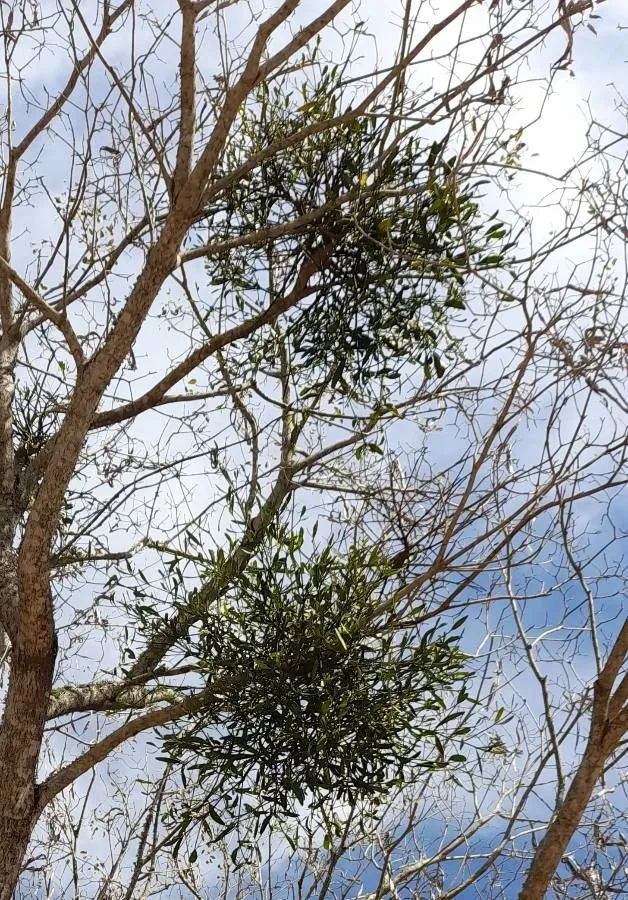
Author: (Kunth) Griseb.
Bibliography: Fl. Brit. W. I.: 711 (1864)
Year: 1864
Status: accepted
Rank: species
Genus: Phoradendron
Vegetable: False
Observations: Mexico to Trop. America
Quacimmila de canario, scientifically known as Phoradendron quadrangulare, belongs to the Santalaceae family. This intriguing plant species was first described and recorded in the work “Fl. Brit. W. I.: 711” published in 1864 and authored by (Kunth) Griseb.
Phoradendron quadrangulare thrives in the diverse climatic conditions from Mexico extending through to tropical regions of America. As a member of the Santalaceae family, it exhibits the characteristic features of parasitic plants found within this group. The plant typically attaches itself to host trees from which it derives its nutrients, a common trait among its relatives.
This species holds ecological significance within its habitat, contributing to the complex web of interactions among flora and fauna. The presence of Phoradendron quadrangulare often indicates a well-established and mature ecosystem, as it relies on established trees for its survival. Additionally, it plays a role in supporting various wildlife, including birds that may feed on its berries and insects benefiting from its blossoms.
Though often overlooked, Phoradendron quadrangulare presents a fascinating subject of study for botanists and ecologists alike, offering insights into the dynamics of parasitic plant species and their role in tropical ecosystems.
Eng: quacimmila de canario
En: Quacimmila de canario
Es: Matapalo
© copyright of the Board of Trustees of the Royal Botanic Gardens, Kew.
© copyright of the Board of Trustees of the Royal Botanic Gardens, Kew.
© copyright of the Board of Trustees of the Royal Botanic Gardens, Kew.
Taken Sep 2, 2022 by Muzzachiodi Norberto (cc-by-sa)
Taken Oct 17, 2015 by Nelson Zamora Villalobos (cc-by-nc)
Taken Jun 10, 2014 by Nelson Zamora Villalobos (cc-by-nc)
Taken Jan 7, 2022 by Trap Hers (cc-by-sa)
Taken Jul 21, 2022 by Trap Hers (cc-by-sa)
Taken Sep 2, 2022 by Muzzachiodi Norberto (cc-by-sa)
Taken Sep 26, 2022 by ODwyer patricio (cc-by-sa)
Taken Jan 7, 2022 by Trap Hers (cc-by-sa)
Taken Sep 19, 2022 by Lais Lais (cc-by-sa)
Taken Jul 21, 2022 by Trap Hers (cc-by-sa)
Taken Jun 10, 2014 by Nelson Zamora Villalobos (cc-by-nc)
Taken Sep 2, 2022 by Muzzachiodi Norberto (cc-by-sa)
Taken Sep 2, 2022 by Muzzachiodi Norberto (cc-by-sa)
Taken Jul 20, 2021 by Trap Hers (cc-by-sa)
Taken Jan 7, 2022 by Trap Hers (cc-by-sa)
Taken Jan 7, 2022 by Trap Hers (cc-by-sa)
Taken Jul 21, 2021 by Trap Hers (cc-by-sa)
Growth habit>: Subshrub, Shrub
Family: Myrtaceae Author: (F.Muell.) K.D.Hill & L.A.S.Johnson Bibliography: Telopea 6: 402 (1995) Year: 1995 Status:…
Family: Rubiaceae Author: Pierre ex A.Froehner Bibliography: Notizbl. Bot. Gart. Berlin-Dahlem 1: 237 (1897) Year:…
Family: Sapindaceae Author: Koidz. Bibliography: J. Coll. Sci. Imp. Univ. Tokyo 32(1): 38 (1911) Year:…
Family: Asteraceae Author: A.Gray Bibliography: Pacif. Railr. Rep.: 107 (1857) Year: 1857 Status: accepted Rank:…
Family: Fabaceae Author: Medik. Bibliography: Vorles. Churpfälz. Phys.-Ökon. Ges. 2: 398 (1787) Year: 1787 Status:…
Family: Aspleniaceae Author: (Cav.) Alston Bibliography: Bull. Misc. Inform. Kew 1932: 309 (1932) Year: 1932…